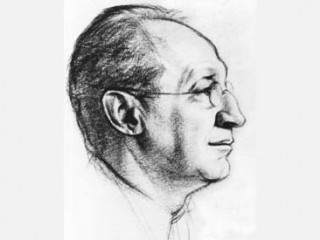
Charles Seligman biography
Date of birth : 1873-12-24
Date of death : 1940-09-19
Birthplace : London, England
Nationality : British
Category : Science and Technology
Last modified : 2010-09-07
Credited as : Anthropologist and scientist, pioneer of ethnography, researches in Melanesia, Ceylon (now Sri Lanka)
0 votes so far
Charles Gabriel Seligman (born December 24, 1873 – died September 19, 1940) was a British pioneer of ethnography. He conducted significant field research in Melanesia, Ceylon (now Sri Lanka), and the Nilotic Sudan. His work, The Melanesians of British New Guinea, published in 1910, has remained an essential source material for studies of the cultures of the Torres Strait Islanders.
Seligman's work in the Sudan, conducted together with his wife, led to many publications and much interest in the people and races of Africa. Influential in academic circles, he was responsible for the shift in focus of British anthropology from Pacific to African cultures. Although his thesis concerning the races of Africa was erroneous, the detailed descriptions provide a valuable source of information for the study of human history, and drew attention to Africa as significant regarding the origins of humankind.
Seligman’s Life
Charles Gabriel Seligman was born in London, England, the only child of Hermann Seligmann and Olivia Mendez da Costa. He studied medicine at St. Thomas' Hospital in London, earning his medical qualification in 1896 at the age of 23. In the same year he received the Bristowe medal in pathology, after which he practiced as a pathologist for several years.
In 1898, Seligman joined an expedition organized by the University of Cambridge to the Torres Strait. The expedition was led by Alfred C. Haddon, and had the goal of documenting the rapidly vanishing cultures of the Islanders. This experience changed his life, and he decided to dedicate himself completely to anthropology.
The Torres expedition was followed by many further expeditions, and Seligman joined several of them. He first traveled to New Guinea in 1904, and then to Ceylon from 1906 to 1908. In 1910 he became Reader in Anthropology in the London School of Economics, and taught there along with Bronislaw Malinowski and Edvard Westermarck.
In 1905, Seligman married Brenda Zara Salaman, who would accompany him on many of his expeditions and whom he relied on significantly, crediting her in his publications. They visited south Sudan for the first time in 1909, and spent three years studying local cultures. They went again to Sudan in 1921, staying one year.
Seligman also wrote on the cultures of New Guinea, Ceylon, India, and China. He had a great love for oriental art and collected Chinese jades.
During World War I Seligman returned to his medical profession, treating shellshock victims.
He served as chair of Ethnology at the University of London from 1913 to 1934, the first chair of its kind in the University. He retired in 1934, and was awarded the title of Emeritus Professor. From 1923 to 1925 he was president of the Royal Anthropology Institute and he was a visiting professor at Yale University in 1938. He was Huxley Memorial Lecturer and Medalist in 1932, and Frazer Lecturer in 1933.
Seligman became chronically ill during his fieldwork in Sudan, the victim of an infection that made him a semi-invalid. He mostly resided at his countryside home in Toot Baldon near Oxford, England, where he died on September 19, 1940.
Seligman’s Work
Seligman’s first contact with anthropology came from his work in North Queensland, where he stayed several months to work in the Cape York Peninsula. In 1898 he joined the Cambridge Anthropological Expedition to Torres Straits, led by Alfred C. Haddon. The expedition had the primary goal of recording as much data on local traditions as possible, as the native cultures were slowly disappearing under the devastating impact of colonization.
What they encountered there was that the cultures did not entirely disappear, but were remolded under the influence of Christianity and other neighboring cultures. Seligman believed that in order to study the local customs, one needs to take into account all of the influences from the environment. Since the Torres Strait Islands are situated at a crossroads between the Indian and Pacific Oceans, they were particularly prone to foreign influences.
Seligman also carried out significant ethnographic work in Africa, including Egypt and Sudan. He visited Egypt twice early in the twentieth century, collecting artifacts and recording data in the areas around Abydos and Thebes. At Abydos he discovered discolored circles on the desert surface, and interpreted them as remains of the Paleolithic huts. Scientists today are still not sure of the origin of these circles. Seligman also published the first study of Egyptian prehistory.
Seligman’s work in Sudan included study of various Nilotic communities who lived in the Southern Sudan, including the Nuer, Dinka, Shilluk, and Anuak.
His approach to the origin of African races, which he carried out with his usual passion for documentation, also contains what is perhaps his greatest fallacy. His book The Races of Africa supports the Hamitic hypothesis, which held that all civilizations in Africa were the result of a resident population of Caucasians:
Apart from relatively late Semitic influence…the civilizations of Africa are the civilizations of the Hamites, its history the record of these peoples and of their interaction with the two other African stocks, the Negro and the Bushman, whether this influence was exerted by highly civilized Egyptians or by such wider pastoralists as are represented at the present day by the Beja and Somali…The incoming Hamites were pastoral ‘Europeans’–arriving wave after wave–better armed as well as quicker witted than the dark agricultural Negroes." (Seligman 1930)
Overall, Seligman’s work can be essentially characterized as ethnographic. He liked details, and wanted to document every smallest piece of information. He believed that anthropologists need to focus on details, because, according to him, theories in ethnography might change, but the facts that they were based on would always be of use. Seligman’s papers and books were thus always full of data. Indeed, the data he accumulated and published in The Races of Africa have remained useful after his theoretical statements were discredited.
Seligman retained a Darwinian evolutionary approach which essentially linked culture to biology. He was interested in psychoanalysis and believed that ethnology and psychology could go hand in hand in explaining the history of cultural development. He was much interested in the practical use of anthropology, and was involved in the branch of anthropology later known as applied anthropology.
Legacy
Charles G. Seligman played a significant role in the history of British anthropology. He was instrumental in moving the focus of British anthropologists from the Pacific Islands (which occupied most studies well into the 1920s) to Africa. His student, E. E. Evans-Pritchard, continued the research of his teacher, and published numerous papers on the cultures of Sudan.
Seligman and his wife conducted many field studies together, establishing the tradition that field work can be most effectively carried out by anthropologist couples.
Seligman was the teacher of some of the most famous names of modern British anthropology, including Bronislaw Malinowski, Jack H. Driberg, E. E. Evans-Pritchard, Isaac Schapera, Raymond Firth, Siegfried F. Nadel, and Meyer Fortes.
Although a semi-invalid for many years, Seligman continued his work at home where those in the anthropological community visited him. Known by most by the nickname "Sliggs," he continued to attract affection as well as respect from his colleagues.
Publications
* Seligman, Charles G. 1902. Sexual inversion among primitive races. The Alienist and Neurobiologist. St. Louis.
* Seligman, Charles G. 1902. The medicine, surgery, and midwifery of the Sinaugolo.
* Seligman, Charles G. [1910] 1975. Melanesians of British New Guinea. Ams Press Inc.
* Seligman, Charles G. [1911] 1976. The Veddas. Ams Press Inc. I
* Seligman, Charles G. 1921. The older palaeolithic age in Egypt. London: Royal Anthropological Institute of Great Britain and Ireland.
* Seligman, Charles G. [1930] 1966. The Races of Africa. London: Oxford University Press.
* Seligman, Charles G. 1931. Japanese temperament and character. London: Transactions of the Japan Society.
* Seligman, Charles G. 1932. Anthropological perspective and psychological theory. Huxley memorial lecture, 1932. London: Royal Anthropological Institute of Great Britain and Ireland.
* Seligman, Charles G. 1934. Egypt and Negro Africa: A Study in Divine Kingship. Ams Press Inc.
* Seligman, Charles G. & Brenda Z. Seligman. 1932. Pagan tribes of the Nilotic Sudan. London: G. Routledge & Sons.
* Seligman, Charles G. & C. P. Fitzgerald. 1938. China, a short cultural history. New York: D. Appleton-Century Co.
* Seligman, Charles G. & Horace C. Beck. 1938. Far Eastern glass: Some Western origins. Stockholm: Museum of Far Eastern Antiquities.
















